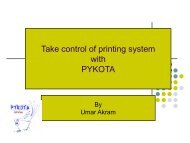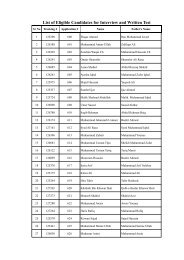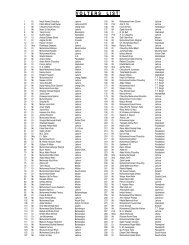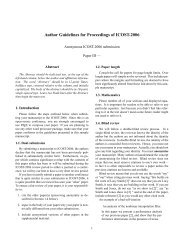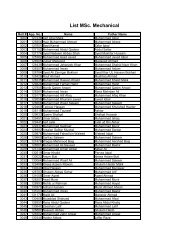FPGA Fabric Specific Optimization for RTL Design - University of ...
FPGA Fabric Specific Optimization for RTL Design - University of ...
FPGA Fabric Specific Optimization for RTL Design - University of ...
You also want an ePaper? Increase the reach of your titles
YUMPU automatically turns print PDFs into web optimized ePapers that Google loves.
<strong>FPGA</strong> <strong>Fabric</strong> <strong>Specific</strong> <strong>Optimization</strong> <strong>for</strong> <strong>RTL</strong> <strong>Design</strong><br />
output ports to generate high speed carry propagation as<br />
shown in Fig 1.<br />
present in the <strong>FPGA</strong> and utilizing the faster<br />
interconnectivity yield minimum path delay.<br />
Each DSP48 present in the <strong>FPGA</strong> can add three stages<br />
<strong>of</strong> pipelining in the multiply and accumulate (MAC)<br />
operation. If pipelining is not used these registers are<br />
bypassed, there<strong>for</strong>e addition <strong>of</strong> these pipeline stages<br />
improves the per<strong>for</strong>mance manifolds without causing any<br />
hardware overhead.<br />
A. Compression Trees<br />
Fig 1<br />
Virtex-5 configurable logic blocks (CLBs)<br />
comprise two slices.<br />
Different combinational logics are realized by<br />
combination <strong>of</strong> LUTs having different data input and output<br />
patterns. Virtex 5 <strong>FPGA</strong> has six input and one output LUT,<br />
the single LUT can output one bit data from six bit input<br />
data, if this resource is properly used <strong>for</strong> the circuit design, it<br />
may be possible to obtain more compact and high<br />
per<strong>for</strong>mance circuit. There<strong>for</strong>e it is imperative <strong>for</strong> circuits to<br />
be implemented in <strong>FPGA</strong> to consider the structure while<br />
designing and optimizing the algorithm.<br />
Fig 2 DSP 48 slice in Vertex 5 <strong>FPGA</strong><br />
Xilinx with Virtex-5 DSP48 unit has a clock rate <strong>of</strong><br />
550 MHz and the precision <strong>of</strong> 25 x 18 bits as per fig 2.<br />
Xilinx has optimized the Virtex-5 DSP48 slice <strong>for</strong> adder<br />
chain implementations which is a powerful capability that<br />
enables the creation <strong>of</strong> very efficient high-per<strong>for</strong>mance<br />
filters [5].<br />
After in detail study <strong>of</strong> the structure <strong>of</strong> Virtex 5 <strong>FPGA</strong><br />
it is clear that the express fabric which has carry chain and<br />
six input LUT yield the most effective trade<strong>of</strong>f between<br />
critical path delay which is the determining factor <strong>for</strong> logic<br />
fabric per<strong>for</strong>mance and die size. Due to the regular routing<br />
pattern <strong>of</strong> the express fabric the interconnectivity between<br />
six LUTs enhances per<strong>for</strong>mance by reaching more places in<br />
fewer hops. Any algorithm involving multiplication<br />
reduction technique can be implemented using 6:3<br />
compression trees structure instead <strong>of</strong> 4:2 or 3:2 or any<br />
other, so that it is mapped efficiently onto the 6 LUTs<br />
Compression trees are used to add different partial<br />
products <strong>of</strong> a multiplication and eliminate the need <strong>for</strong> usage<br />
<strong>of</strong> dedicated multiplier hardware. For a known coefficient<br />
multiplication it is always desirable to use CSD to generate<br />
minimum partial products and further optimization is carried<br />
out by using different Wallace compression trees [4].<br />
Traditionally the 4:2 Wallace tree has been considered the<br />
most efficient compression choice <strong>for</strong> VLSI design but in<br />
case <strong>of</strong> <strong>FPGA</strong>s the results depend upon the inherent LUT<br />
structure, as we have used Virtex 5 <strong>FPGA</strong> in our<br />
experiments that has 6:1 LUTs, there<strong>for</strong>e the choice <strong>of</strong> 6:3<br />
compression tree outper<strong>for</strong>ms that <strong>of</strong> others.<br />
B. Multiplier Pipelining<br />
DSP 48 block integral in Virtex 5 <strong>FPGA</strong>s is a multiply<br />
and accumulate block that has special hardware 18 x 25 bits<br />
multiplier and a 48 bit accumulator that has 3 input ports<br />
and 1 output port. The block has inherent 3 stages <strong>of</strong><br />
pipelines as shown in fig 2. The inputs are pipelined through<br />
A and B registers (Regs), the multiplier and adder using M<br />
Reg and the output using P Reg. Thus any multiply<br />
accumulate operation can be pipelined efficiently up to a<br />
maximum <strong>of</strong> 4 levels without incurring any additional<br />
hardware overhead. These stages can effectively increase<br />
the throughput <strong>of</strong> a digital design ranging from 80 to 500<br />
MHz [5].<br />
C. Bit Width <strong>Optimization</strong><br />
Selection <strong>of</strong> bit resolution <strong>for</strong> algorithm<br />
implementation plays an interesting role as far as the<br />
hardware complexity, mean square error (MSE) and power<br />
consumption is concerned. Sometimes increasing the bit<br />
resolution has drastic effects on hardware complexity as<br />
compared to the decrease in MSE [8]. The used bit width<br />
when correlated with the underlying fabric structure <strong>of</strong> the<br />
<strong>FPGA</strong> yields some per<strong>for</strong>mance slots/bands. The design<br />
choice is there<strong>for</strong>e reduced to selection <strong>of</strong> one or the other<br />
architecture based upon optimization <strong>of</strong> the characteristics<br />
<strong>of</strong> user choice yielding minimum bit width and highest<br />
per<strong>for</strong>mance slot.<br />
DESIGN OPTIMIZATIONS<br />
To study the effects <strong>of</strong> the discussed hardware design<br />
optimizations three case studies were done, first a FIR filter<br />
[6] was implemented using direct, systolic and trans<strong>for</strong>med<br />
53






